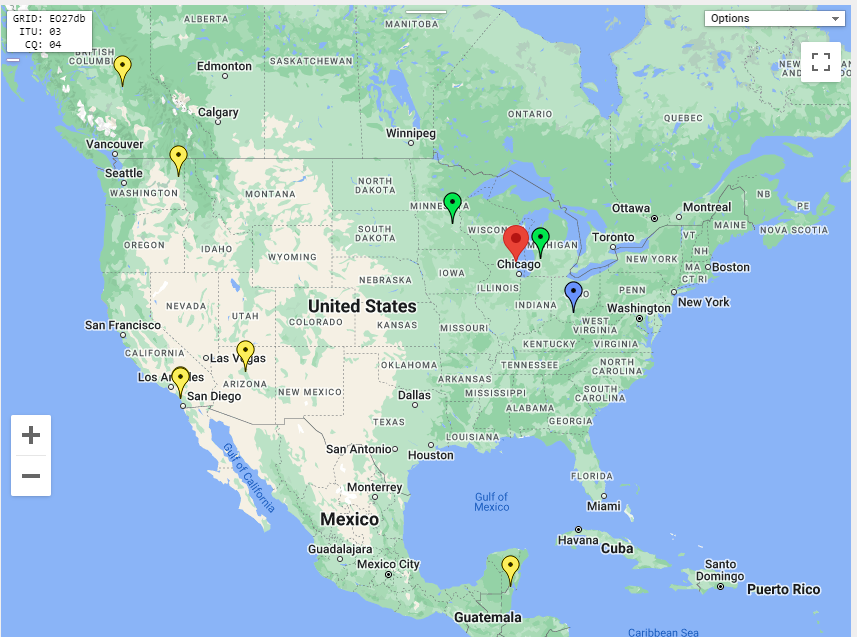Radio Ramblings: The HF Journey, part 2 (16 February 2024 CE)

I'm in danger of actually forgetting my first few days actually operating my HF rig before I write down anything about it, so, here I am, finally writing things down.
Right now, I don't have a good way to set up a true "shack", and permanent antennas. The most obvious room in the house to make into the shack is the office. The office is simply not configured for it yet, and to get there, it needs to be significantly destashed and decluttered. That project is underway, but it's going to take a while. But, for example, right now, I have no good way to access the outer wall I would need to bring antenna cables through!
That hasn't slowed me down that much, though, because portable operation is already something that sparked my interest early on. What has slowed me down a bit, though, is the fact that it's winter! Fortunately, as winters go, this one's been pretty mild.
So, having gotten together my equipment, I took advantage of a few of those mild evenings, starting a bit before the sun went down, and started practicing setting up the equipment in my backyard.
Practice makes adequate
I had already set up the radio a bit. It arrived first, along with a useful kit of adapters between different coax-fitting standards. This allowed me to set up my cheap YouLoop magloop antenna to the radio, and at least see what I could receive with it, and start learning the controls.
The antenna was the last piece to arrive, however, so I had to wait a bit to actually transmitting.
I set up three nights in a row. Each night got a little easier. I figured out things I needed, I ordered some, ran by Harbor Freight for others, and for others I just made do for a while. For example, keeping track of ground-plane radials is much easier with wire-winders. I could have made those out of cardboard--G-d knows I have enough cardboard right now!--but I elected to buy a set. Things like that made each set-up easier.
Problems with power
I also learned over time that I had a real problem with power. I had hoped to use my EcoFlow River Max as my main source of portable power. It's got a great capacity, and a whole bunch of different ways to provide electricity to devices. It seemed ideal.
It's really not. To understand why requires a bit of exposition.
Most radio equipment these days runs on 13.8 volts of DC power. This may seem like strange number, until you realize that most 12VDC power sources will satisfy it. As a result, almost everything that targets the amateur radio market can be powered on 12VDC.
In a shack, people tend to run off of power supplies that are similar in concept, but different in particulars, to the power supplies inside desktop computers. AC comes in, DC goes out. Most PC power supplies have a set of very specific outputs for different parts of the PC, while the power supplies for radio tend to be more general.
The radio ships with a long, fused power cable with the radio's HF4 connector at one end, and bare wires at the other end. It's up to you what you're going to hook it up to. You could wire it directly to a car battery if you wanted. I'm not even kidding. That's a valid source of 12VDC.
Most power supplies have the old binding-post terminals. With those, you could either just screw on the wires, or terminate with ring or spade terminals crimped onto the wires. Many also use a standard called Anderson PowerPoles, which are easy to connect, easy to disconnect, and almost foolproof as to polarity. Both solutions also work out well at higher amperages, which will become important in a moment.
My first thought was to use the EcoFlow's DC output, which includes a "cigar lighter" option (the standard car-style 12VDC port). I bought one short length of HF4 (the radio-side) to PowerPole cable, and one short PowerPole to car cable, and ran them to the Ecoflow. Great!
Except that, using that port, the Ecoflow can only provide 10A of current. To achieve full 100W power when transmitting, the Yaesu requires 21A.
So, it worked well enough to boot the radio, to listen to the bands, even attempt a few lower-power calls, but I didn't get the FT710 so I could run at low power. There are other radios I'd get that specialize in operating at low-power, if that were a goal, and some day, it might be. But right now, it's not. Low power, or QRP, is Hard Mode, and I'm a n00b.
OK, thought I. I will hang a 30A power supply off the AC output of the EcoFlow!
From a power standpoint, this worked great! 120VAC to the power supply; 13.8VDC and up to 30A from the power supply to the radio. Great!
Except that the EcoFlow's AC/DC inverter is practically a radio station all by itself. It literally drowned me out. And googling around showed that I Should Have Known This Already. The suburban neighborhood I live in is already a source of background noise, or QRN. But the EcoFlow made entire bands unusable!
Lessons learned
At the end of three nights experimentation, I only had about 4 contacts to my name. Now, that was four more contacts than I'd ever made before, and I felt good about that, but I was very frustrated with the power and noise issues. So I finally did what I probably should have done from the beginning: bought a battery meant for use in hobbies that include amateur radio, in this case, a Bioenno 20Ah battery. It has PowerPoles out, a pretty typical barrel-plug for charging from a brick, it uses up-to-date Lithium-Iron-Phosphate chemistry, no muss, no fuss. For the event described below, I used the same short HF4-to-PowerPole cable I'd used to daisy-chain with the cigar-lighter cable; since then, I've had a friend crimp PowerPoles on the long, fused (25A) cable that came with the radio.
Meanwhile, I also learned a lot about how to set up the antenna. This is by far the "fiddliest" part of the equipment I've chosen. I already described the antenna last time, but as a quick refresher, it's a vertical antenna that uses a loading coil at its base to fool the universe into thinking it's longer than it actually is.
This magic allows it to be used to transmit effectively on bands it ought to be too short for, but it requires one to manually adjust the extension of the whip and the positioning of the tuning collar on the coil. This, in turn, involves a device called an antenna analyzer—which I haven't talked about much because it's some really deep geekery—although there are ways to do it with just the radio, listening to the volume of the noise floor. Louder noise ironically means you've gotten it right.
I now have a better feel for eyeballing whip-length and coil-length, is the upshot here, which will make setting up in the future a bit faster. I could also mark the coil, and many people do, and I might at some point do that. But the truth is, any such marking would only be ballpark. Everything Affects Everything. A setting that's perfect today might be just slightly wrong tomorrow.
Success in a park!
The pictures I posted last time were taken at Long Lake Regional Park. That was my fourth time setting the whole rig up, and the first time not at home (and out in front of other people). It was the first time I got to set up with the Bioenno battery—it arrived just early enough that morning that I could charge it before going to the event—and the first time setting up away from suburban and household RF interference.
It was glorious.
I wound up setting up on the 10-meter band. Right now, with the 11-year solar activity cycle on the rise, the 10-meter band is often wide-open during the day. 10m requires relatively little fiddling with the antenna: make the whip about 2/3ds its full extension, leave the tuning collar all the way up, and you'll get a good "match" and effective transmission.
I made six contacts in three hours, which is not much in the grand scheme of things (during contests, people make hundreds of contacts an hour!), but I could have made far more. The west coast, in particular, was booming in. My first contact of the day was with Spokane, WA; then Deer Park, WA; then Belize; someone in Canada; and finally, I wound up checking in to a "net" running out of North San Diego (which netted contact with both the net control and one other member who explicitly reached out as part of the net).
So why didn't I? Because I was also there to socialize in-person with my fellow hams, for one thing, so there was a lot of time spent talking to people face to face! As a new guy, this was an important reason for me to have gone to the event at all!
I don't think I stopped grinning like an idiot the entire time!


